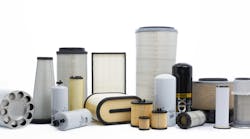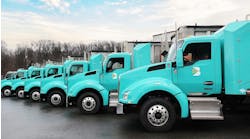A vehicle filter’s media is crucial to both its efficiency and ability to ensure an engine functions properly and reliably. Types of media vary depending on the product and the filter’s purpose, with premium filters using high-tech media that give them an edge over other filters.
Changes to engine oil filters
Extended drain oil filters provide features and functionality to increase filter life. For instance, the XD filter from Mann+Hummel features patent pending Spin Flow Technology. With this technology, angled fins placed where the oil enters the filter start the process of directing heavy particles to the coarse filtration element in order to remove them from the oil. This allows the XD multi-density wire back media in the fine filtration element to trap smaller particles. The XD high-strength media will trap the larger particles being “spun” down and will trap media clogging sludge for vehicles in need of an extra layer of protection. This heavy duty filter has become the standard on some modern engines.
Glass media also serves as a way to filter out harmful particles. This type of media is the most efficient and cost-effective option available for severe conditions. These filters feature microfiber glass media in order to filter out more of the small, engine-destroying particles. Benefits of glass media include lower resistance to oil flow, which provides better protection during engine start-ups, especially in cold weather.
A look at other filter types
The filtration industry must stay committed to both advanced technology and skillful engineering, knowing that a successful collaboration of the two creates state-of-the-art and reliable products. This philosophy must extend to air and fuel filters as well.
Fuel filters
Media technology will continue to evolve as oil chemistries change and fuels become more specialized. The newest filter medias currently on the market are multi-layered and formed from a combination of natural and synthetic materials. The majority of these media changes are happening on the fuel side as a way to combat the water and contaminants that are destroying injectors.
As system efficiency continues to improve, the pressure at the injector nozzle will continue to climb, and the filter must protect these injector nozzles. It’s also important to remember that water separation properties are critical in the modern diesel fuel available in most areas of North America.
Products like WIX Filters' high-efficiency XE fuel filters feature multi-layer media for enhanced fuel-cleaning and water removal performance.
Engine air filters
The use of nanofiber technology in commercial vehicle and off-road sector applications over the course of several years has improved engine air filter performance. A nanofiber filter media consists of a carrier media, in addition to an extremely thin layer of ultra-fine polymer fibers. The fibers, which measure at a diameter of less than one micrometer, are approximately 200 times smaller than the fiber diameter of the carrier material. The result is a considerable improvement in particle separation. Furthermore, nanofibers offer very low flow restriction and the high separation performance ensures that smaller particles are separated by the nanofiber layer of the filter media.
Designed to hold finer contaminants for a longer service interval, filters with nanofiber technology provide superior protection for demanding on- and off-road trucks, fleets, mining, and agriculture environments. These air filters offer greater protection for both the engine and its sensitive components because the technology provides higher initial efficiency and a final efficiency up to 99.99 percent.
Setting future expecations
As technology and fleet needs continue to evolve, the filtration industry must focus its efforts on acquiring expert knowledge and advanced technology to develop high-performance filter media that meets increasing customer requirements.
Access to simulations, laboratory tests, and special analysis software to improve nanofiber coatings for customized applications, in addition to combining technology with other media and materials, will prove advantageous.
In the development process, companies should utilize analysis software that is able to automatically determine the fiber diameter distribution and pore size distribution from scanning electron microscope images of nanofibers. This distribution substantially determines the separation efficiency and flow resistance of the media. The current age of measuring distribution has eliminated the need for stuffing cotton waste into a can. Those days are long behind us, as media is now tailor-made to both the application and customer needs.
As we look ahead to the future of new media technology, the industry must remain committed to advanced filtration products on which fleets can rely. Today, companies are beginning to model three-dimensional structures of the media of the future. These technological innovations will certainly impress positive advancement within the industry.




